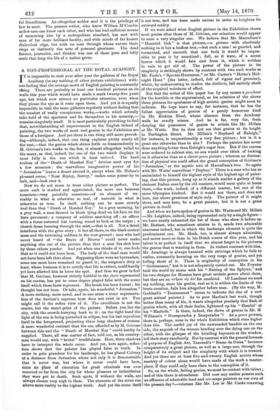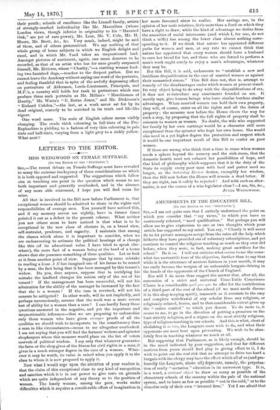A NON-PROFESSIONAL AT THE ROYAL ACADEMY.
IT is impossible to visit year after year the galleries of the Royal Academy (to say nothing of other picture exhibitions) with- out feeling that the average merit of English painting is constantly rising. There are probably at least one hundred pictures on its walls this year which would have made a mark twenty-five years ago, but which now attract no particular attention, even when they please the eye as it rests upon them. And yet it is equally impossible to visit the same galleries regularly without feeling that the number of really conspicuous works,—works which actually take hold of the spectator and fix themselves in his memory,— remains singularly small. It is most particularly provoking to find that, notwithstanding all improvement in the English School of painting, the two works of most real genius in the Exhibition are those of a foreigner. And yet there is one thing still more provok- ing—although, indeed, that one thing explains pretty nearly all the rest,—that the genius which shines forth so transcendently in M. Gerome's two works to the few, is almost altogether veiled to the many, so that, indeed, the one of the two which displays it most fully is the one which is least noticed. The hard realism of the "Death of Marshal Ney " detains most eyes for a few moments ; the marvellous imaginative power of his " Jerusalem " leaves a desert around it, except when Mr. Hulme's pleasant scene, "Near Ripley, Surrey," makes some passer-by to halt, and—look over it.
Now we do not mean to treat either picture as perfect. The more each is studied and appreciated, the more one becomes conscious—very painfully conscious—of an element of un- reality in what is otherwise so real, of untruth in what is otherwise so true. In itself, nothing can be more sternly real than that "Death of Marshal Ney." In a grey morning, by a grey wall, a man dressed in black lying dead on his face on the bare pavement; a company of soldiers marching off ; an officer with a three-cornered hat turning round to look at the corpse ; a church dome looming through the mist,—that is all. Not a detail interferes with the grim story ; it lies all there, in the black central mass and the retreating soldiers in the rear-ground ; men who had never heard of "the Brave of Braves" could never make anything else out of the picture than that a man lies shot here by those others yonder. And yet when one thinks of it, one feels that so it could not have been. The body of the dead man would not have been left thus alone. Supposing there were no bystanders, some one must have remained to guard it ; the surgeon's duty at least, whose business it is to certify that life is extinct, could hardly yet have allowed him to leave the spot. And thus we grow to feel that M. Gerome, however strictly faithful to the facts represented on his canvas, has yet to some degree played false with the scene itself which those facts represent. His brush has been honest ; his thought has not been. Or take, again, his wonderful "Jerusalem." A more striking, more novel, and in one sense a truer representa- tion of the Saviour's supreme hour does not exist in art. You might call it the reflex view of it. The crucifixion is not the centre, but the stand-point of the picture. Before you lies the city, with the crowds hurrying back to it ; on the right hand the light of the sun is being quenched in eclipse, but his last rays shine lurid in the foreground, projecting three long shadows of crosses. A more wonderful contrast than the one afforded us by M. Gerome between this and the "Death of Marshal Ney " could hardly be supplied. There, all was matter of fact, told out, as his country- men would say, with " brutal " truthfulness. Here, three shadows have to interpret the whole scene. And yet, here again, reflec- tion shows that the painter has played false to truth. In order to gain grandeur for his landscape, he has placed Calvary at a distance from Jerusalem where not only it is demonstrable that it never was, but where it never could have been, ODD* DO place Of execution for great criminals was ever removed so far from the city for whose pleasure or intimidation they were put to death. Such spots, if without the walls, are always chosen very nigh to them. The elements of the scene rise above mere reality to the highest truth. And yet the scene itself
is not true, and has been made untrue in order to heighten its outward reality.
If we were asked what English picture in the Exhibition shows most genius after those of M. Gerome, our selection would appear to most a very singular one. We believe that Mr. Maccallum's "Haunted Oak" is that picture,—a picture with absolutely nothing in it but a leafless tree,—but such a tree ! so gnarled, and tormented, and uncouth that one feels it would be impos- sible to pass it by unnoticed ; full, as it were, of a secret horror which it would fain cast from it, which it writhes in vain to get rid of. The power of the picture in its simplicity is strikingly shown by contrast with two such works as Mr. Poole's "Spectre Huntsman," or Mr. Carter's " Herne's Mid-
night Hunt" (the latter, indeed, full of vigour and promise), which, by endeavouring to realize the diablerie, fall entirely short. of the required weirdness of effect.
Not that the writer of this paper has by any means a penchant for the horrible or the supernatural, as his selection of the above three pictures for specimens of high artistic genius might seem to indicate. He begs leave to say, for instance, that he has the fullest appreciation of genius of a purely humorous kind in Mr. Erskine Nicol, whose absence from the Academy walls he cruelly misses. And he is far, very far, from denying the possession of genius to artists like Mr. Millais or Mr. Watts. But he does not see that genius at its height in Burlington Street. Mr. Millais's "Boyhood of Raleigh," for instance, is unquestionably a very fine picture ; but is it a great one otherwise than in size ? Perhaps the painter has never done anything better than Raleigh's eager face. But if the canvas. were reduced to cabinet size, no one would ever think of looking on it otherwise than as a clever genre picture ; whereas no diminu- tion of physical size could affect the grand conception of Ger8me's "Jerusalem," or the mystic awe of Maccallum's tree. So again with Mr. Watts' marvellous "Daphne." There is a man who has so assimilated to himself the highest style of the highest age of paint- ing, that this picture, hung up as it stands amidst a gallery of the choicest Italian ones by the old masters, would seem quite at home there,—the work, indeed, of a different master, but one of the- same Olympian kindred. But it would not there, and does nob here, rise above greatness of style only. The painter of it might there, and may here, be a great painter, but it is not a great picture in itself.
And when we have spoken of genius in Mr. Watts and Mr. Millais. —Mr. Leighton, indeed, being represented only by a single figure-- we have nearly exhausted the list of those who show it before us. Mr. Herbert, who sometimes attains to it, sends two admirable canvasses indeed, but in which the landscape element is quite the predominant one. Mr. Hook, too, is almost always admirable, and never more so than in his Dutch scenes of this year, and his talent is so perfect in itself that we almost forget in his pictures. the genius that is wanting in them. In violent contrast with him, Mr. Armitage is always haunted with strivings which he fails to realize, constantly hovering on the very verge of genius, and yet falling short of it. There is originality of conception in his. "Gethsemane," but it is not adequately carried out. Mr. Poynter took the world by storm with his "Raising of the Sphynx," and his two designs for Mosaics have great archaic power about them, but they are no 2mi-ham Ek etel for mankind. Of Landseer we need say nothing, since his genius, real as it is within the limits of the brute creation, fails him altogether before man. (By the way, M. Goddard's " Tournament " seems to indicate the rise of a new great animal painter.) As to poor Maclise's last work, though better than many of his, it wants altogether precisely that flash of genius which, with all their faults, lightened up his "Hamlet" or his "Macbeth." Is there, indeed, the dawn of genius in Mr. Williams's " Desesperados y Inesperados "? As a genre picture., there is, perhaps, none in the whole Exhibition which rises higher than this. The sordid joy of the unwounded bandits on the one side, the anguish of the woman bending over the dying one on the other, with the glimpse of the bristling bayonets at the window, tell their story excellently. But by contrast with the general lowness. of purpose of English Art, Tancredi's Buoso da Duira " becomes comparatively a great picture, as well as a large one, through the height of its subject and the simplicity with which it is treated. And yet there are at least five-and-twenty English artists whose mastery of colour alone would have made of the work a master- piece, if they could only have risen to the conception of it.
So, on the whole, failing genius, we must be content with talent ; and of this there is abundance. Did ever any nation possess such an affluence of admirable land and sea-scape painters as our own of the present day ?—veterans like Mr. Lee or Mr. Cooke renewing
their youth ; schools of excellence like the Linnell family, artists of strongly-marked individuality like Mr. Maceallum (whose London views, though inferior in originality to his "Haunted Oak," are yet of rare power), Mr. Lear, Mr. V. Cole, Mr. H. Moore, Mr. Brett, Sze., &c. Very much, indeed, might be said of these, and of others pretermitted. We say nothing of that whole group of home subjects iu which we English delight and excel, and in which Mr. Feed takes an unquestioned lead. Amongst pictures of sentiment, again, one name deserves to be recorded, as that of an artist who has for once greatly surpassed himself, Mr. Rivieres, whose " Charity,"—a starving woman feed- ing two famished dogs,—reaches to the deepest pathos. But we cannot leave the Academy without saying one word of the portraits, and feeling thankful that in spite of the awfully depressing effect on portraiture of Aldermen, Lords-Lieutenant, Principals, and M.P.'s, a country still holds her rank in portraiture which can produce three such portraits as Mr. Millais's "Marchioness of Huntly," Mr. 1Vatts's "E. Burne Jones," and Mr. Dickinson's "Richard Cobden,"—the last, as a work never sat for by its dead original, scarcely to be matched in its truth and life-like vigour.
One word more. The scale of English colour seems visibly changing. The crude thick colouring in full tints of the Pre- Raphaelites is yielding to a fashion of very thin colouring in pale tints and half-tints, varying from a light grey to a sickly yellow. What next ?































 Previous page
Previous page